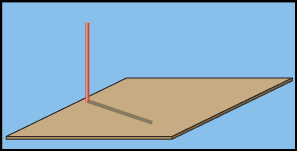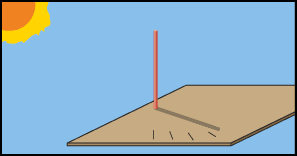| What
to Do |
 |
Glue
the wooden stick to the cardboard square so that it stands upright
(as shown in the sketch below). To assure that the full shadow fits
on the cardboard, you may want to glue the stick closer to one of
the edges.

|
 |
Once
the glue is dried and the stick can stand by itself, place the cardboard
square on a flat surface where it will be exposed to the Sun. Take
note of the time of day. Mark the point on the board where the tip
of shadow is located and write the date.

|
 |
It
is very important that the board be oriented in the same direction
each time you lay it on the ground to mark the board. You might mark
one of the edges of the cardboard square as a point of orientation. |
 |
Repeat
this daily or weekly at the exact same time each day. |
 |
Discuss
your observations with your family. Ask them if they think that there
are any days where the shadow will appear in the same place at the
same exact time. Ask them if they think that there are places on the
planet where the shadow would appear at the same place at the same
time every day. |
|

What's Going On
The
cause of the change in the shadow's location (i.e. the location
of the Sun) is the tilt of the Earth's axis which causes the Earth
to face the Sun at an angle of 23 degrees. Depending on where the
Earth is located in its orbit around the Sun determines the length
of the day. Since the Earth's location around the Sun is changing
continuously, so are the length of the days.
The only two days where the Sun's location matches at any time are
March 21 (Vernal Equinox) and September 21 (Autumnal Equinox).
The only place on the Earth where the Sun's location matches everyday
is on the equator.
If your family continued this experiment the whole year round and
connected the dots of your markings, the picture would look as follows.
(Note the point of intersection. That point is where March 21 and
September 21 fall.)
|
|
|


